Analysis of Technological Innovations Changing the Third Decade
VerifiedAdded on 2020/07/22
|11
|3887
|83
Report
AI Summary
This report delves into the technological innovations anticipated to reshape the third decade of the 21st century. It begins with an introduction outlining the research aim, objectives, and hypothesis, followed by a discussion of the conceptual and theoretical underpinnings, including General Diffusion Theory and developer-based theories. The report examines advancements in various fields, such as automobiles, energy sources, and electronics, highlighting both the advantages and disadvantages of these innovations. The research design is based on analytical and qualitative aspects, utilizing secondary data from articles, books, and online sources. The results section synthesizes findings from various researchers, discussing the impact of innovation on industrial structures, education, and global competitiveness. It acknowledges the increasing dependency on technology and its potential negative impacts. The report concludes by emphasizing the importance of technological innovation across various sectors and recommending ways to mitigate its adverse effects on society and the environment, showcasing the transformative potential of emerging technologies.
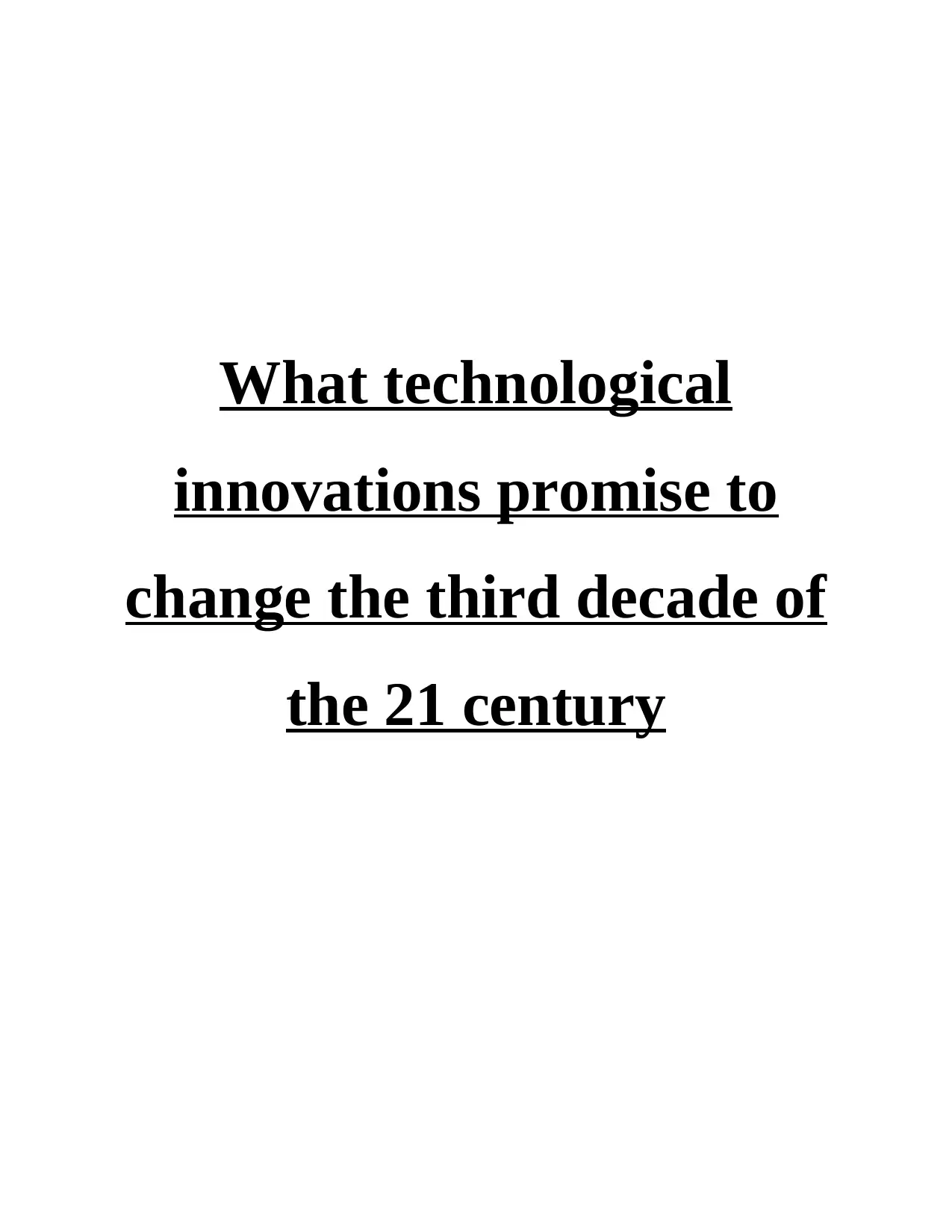
What technological
innovations promise to
change the third decade of
the 21 century
innovations promise to
change the third decade of
the 21 century
Paraphrase This Document
Need a fresh take? Get an instant paraphrase of this document with our AI Paraphraser
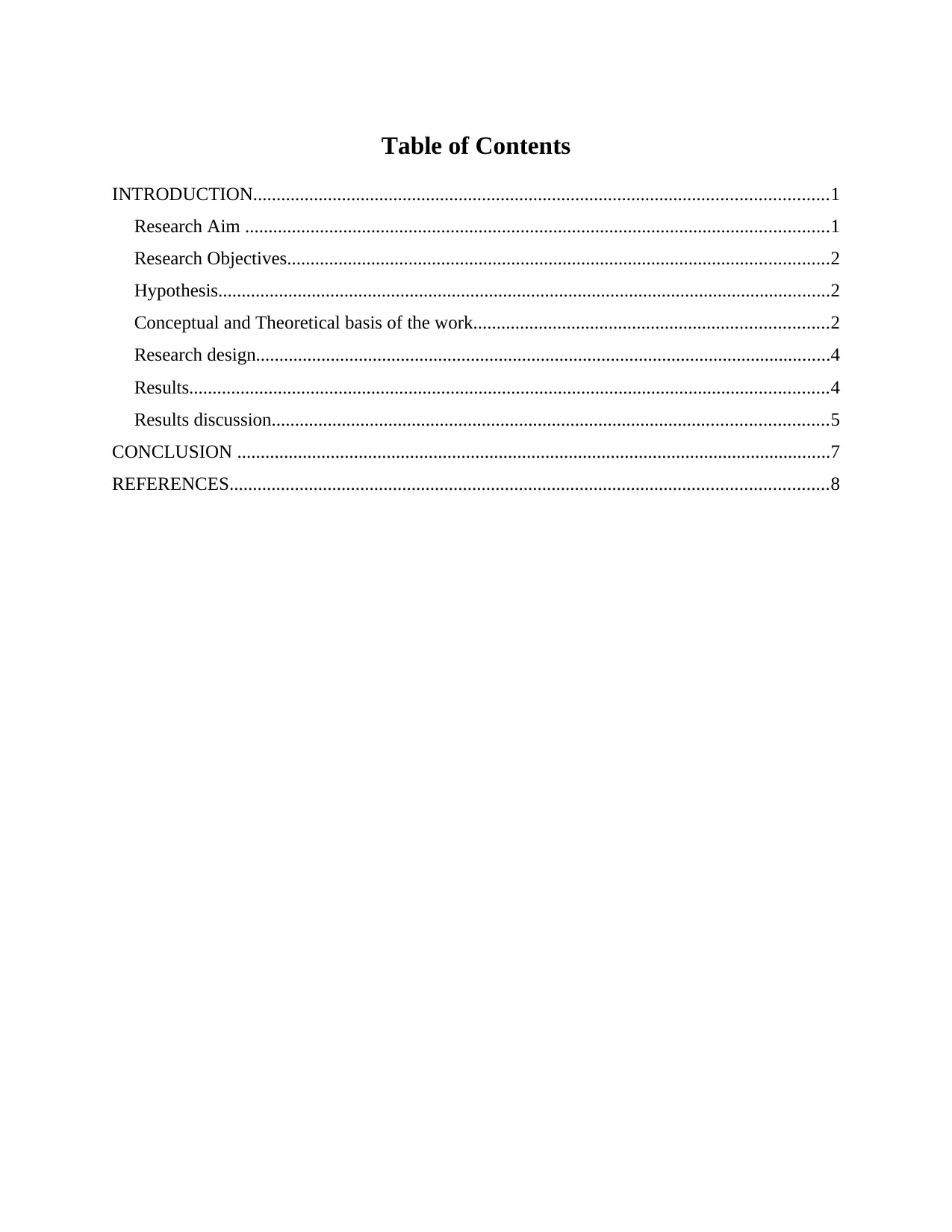
Table of Contents
INTRODUCTION...........................................................................................................................1
Research Aim .............................................................................................................................1
Research Objectives....................................................................................................................2
Hypothesis...................................................................................................................................2
Conceptual and Theoretical basis of the work............................................................................2
Research design...........................................................................................................................4
Results.........................................................................................................................................4
Results discussion.......................................................................................................................5
CONCLUSION ...............................................................................................................................7
REFERENCES................................................................................................................................8
INTRODUCTION...........................................................................................................................1
Research Aim .............................................................................................................................1
Research Objectives....................................................................................................................2
Hypothesis...................................................................................................................................2
Conceptual and Theoretical basis of the work............................................................................2
Research design...........................................................................................................................4
Results.........................................................................................................................................4
Results discussion.......................................................................................................................5
CONCLUSION ...............................................................................................................................7
REFERENCES................................................................................................................................8
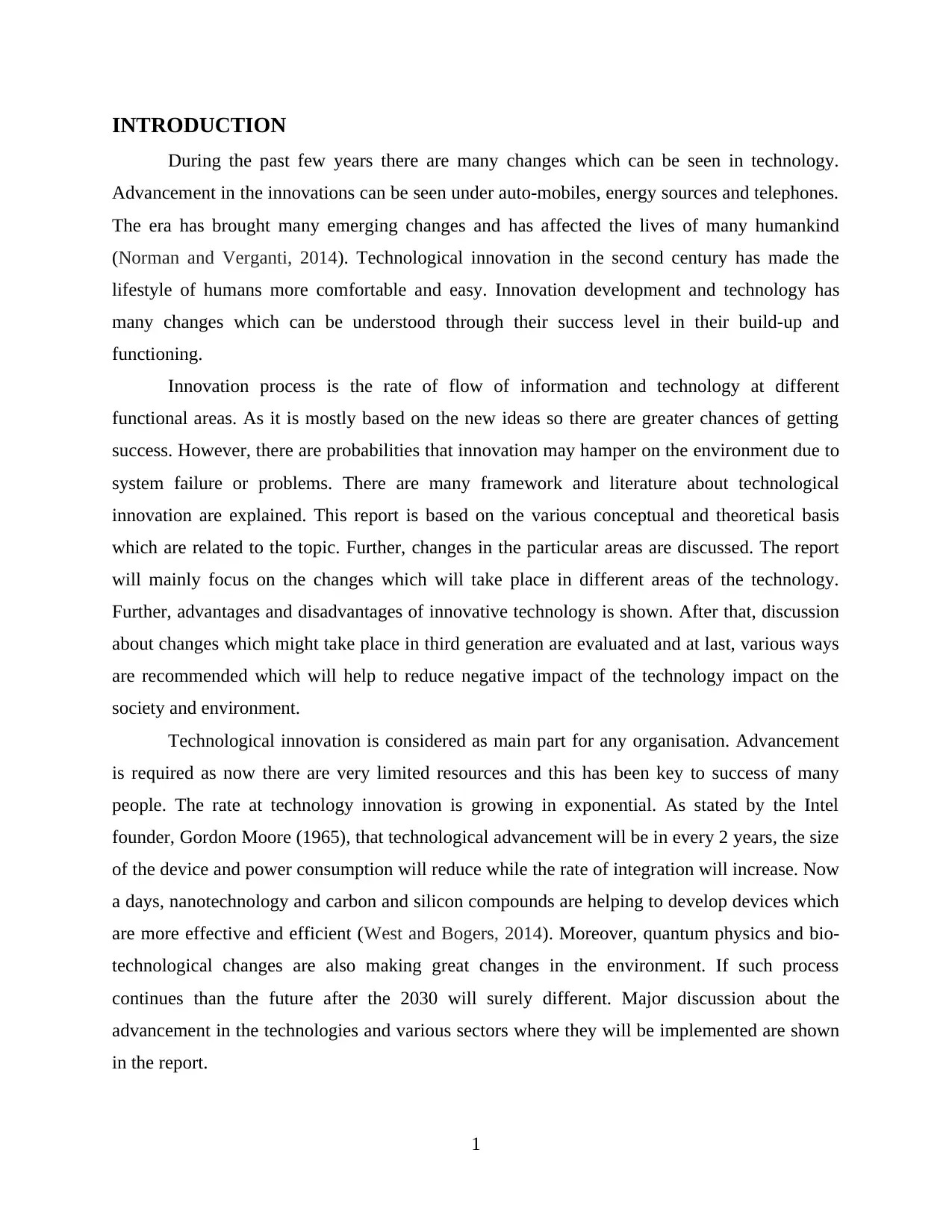
INTRODUCTION
During the past few years there are many changes which can be seen in technology.
Advancement in the innovations can be seen under auto-mobiles, energy sources and telephones.
The era has brought many emerging changes and has affected the lives of many humankind
(Norman and Verganti, 2014). Technological innovation in the second century has made the
lifestyle of humans more comfortable and easy. Innovation development and technology has
many changes which can be understood through their success level in their build-up and
functioning.
Innovation process is the rate of flow of information and technology at different
functional areas. As it is mostly based on the new ideas so there are greater chances of getting
success. However, there are probabilities that innovation may hamper on the environment due to
system failure or problems. There are many framework and literature about technological
innovation are explained. This report is based on the various conceptual and theoretical basis
which are related to the topic. Further, changes in the particular areas are discussed. The report
will mainly focus on the changes which will take place in different areas of the technology.
Further, advantages and disadvantages of innovative technology is shown. After that, discussion
about changes which might take place in third generation are evaluated and at last, various ways
are recommended which will help to reduce negative impact of the technology impact on the
society and environment.
Technological innovation is considered as main part for any organisation. Advancement
is required as now there are very limited resources and this has been key to success of many
people. The rate at technology innovation is growing in exponential. As stated by the Intel
founder, Gordon Moore (1965), that technological advancement will be in every 2 years, the size
of the device and power consumption will reduce while the rate of integration will increase. Now
a days, nanotechnology and carbon and silicon compounds are helping to develop devices which
are more effective and efficient (West and Bogers, 2014). Moreover, quantum physics and bio-
technological changes are also making great changes in the environment. If such process
continues than the future after the 2030 will surely different. Major discussion about the
advancement in the technologies and various sectors where they will be implemented are shown
in the report.
1
During the past few years there are many changes which can be seen in technology.
Advancement in the innovations can be seen under auto-mobiles, energy sources and telephones.
The era has brought many emerging changes and has affected the lives of many humankind
(Norman and Verganti, 2014). Technological innovation in the second century has made the
lifestyle of humans more comfortable and easy. Innovation development and technology has
many changes which can be understood through their success level in their build-up and
functioning.
Innovation process is the rate of flow of information and technology at different
functional areas. As it is mostly based on the new ideas so there are greater chances of getting
success. However, there are probabilities that innovation may hamper on the environment due to
system failure or problems. There are many framework and literature about technological
innovation are explained. This report is based on the various conceptual and theoretical basis
which are related to the topic. Further, changes in the particular areas are discussed. The report
will mainly focus on the changes which will take place in different areas of the technology.
Further, advantages and disadvantages of innovative technology is shown. After that, discussion
about changes which might take place in third generation are evaluated and at last, various ways
are recommended which will help to reduce negative impact of the technology impact on the
society and environment.
Technological innovation is considered as main part for any organisation. Advancement
is required as now there are very limited resources and this has been key to success of many
people. The rate at technology innovation is growing in exponential. As stated by the Intel
founder, Gordon Moore (1965), that technological advancement will be in every 2 years, the size
of the device and power consumption will reduce while the rate of integration will increase. Now
a days, nanotechnology and carbon and silicon compounds are helping to develop devices which
are more effective and efficient (West and Bogers, 2014). Moreover, quantum physics and bio-
technological changes are also making great changes in the environment. If such process
continues than the future after the 2030 will surely different. Major discussion about the
advancement in the technologies and various sectors where they will be implemented are shown
in the report.
1
⊘ This is a preview!⊘
Do you want full access?
Subscribe today to unlock all pages.

Trusted by 1+ million students worldwide
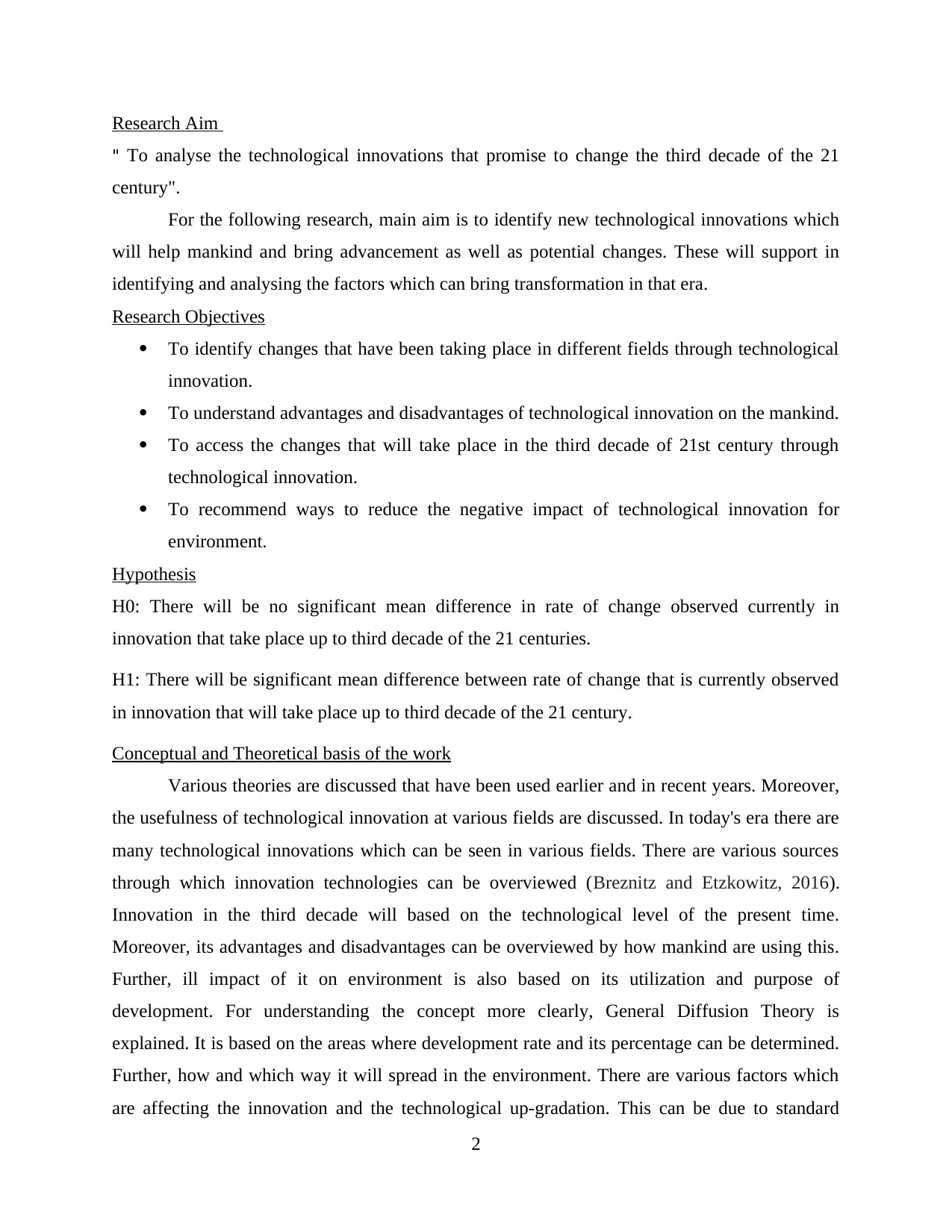
Research Aim
" To analyse the technological innovations that promise to change the third decade of the 21
century".
For the following research, main aim is to identify new technological innovations which
will help mankind and bring advancement as well as potential changes. These will support in
identifying and analysing the factors which can bring transformation in that era.
Research Objectives
To identify changes that have been taking place in different fields through technological
innovation.
To understand advantages and disadvantages of technological innovation on the mankind.
To access the changes that will take place in the third decade of 21st century through
technological innovation.
To recommend ways to reduce the negative impact of technological innovation for
environment.
Hypothesis
H0: There will be no significant mean difference in rate of change observed currently in
innovation that take place up to third decade of the 21 centuries.
H1: There will be significant mean difference between rate of change that is currently observed
in innovation that will take place up to third decade of the 21 century.
Conceptual and Theoretical basis of the work
Various theories are discussed that have been used earlier and in recent years. Moreover,
the usefulness of technological innovation at various fields are discussed. In today's era there are
many technological innovations which can be seen in various fields. There are various sources
through which innovation technologies can be overviewed (Breznitz and Etzkowitz, 2016).
Innovation in the third decade will based on the technological level of the present time.
Moreover, its advantages and disadvantages can be overviewed by how mankind are using this.
Further, ill impact of it on environment is also based on its utilization and purpose of
development. For understanding the concept more clearly, General Diffusion Theory is
explained. It is based on the areas where development rate and its percentage can be determined.
Further, how and which way it will spread in the environment. There are various factors which
are affecting the innovation and the technological up-gradation. This can be due to standard
2
" To analyse the technological innovations that promise to change the third decade of the 21
century".
For the following research, main aim is to identify new technological innovations which
will help mankind and bring advancement as well as potential changes. These will support in
identifying and analysing the factors which can bring transformation in that era.
Research Objectives
To identify changes that have been taking place in different fields through technological
innovation.
To understand advantages and disadvantages of technological innovation on the mankind.
To access the changes that will take place in the third decade of 21st century through
technological innovation.
To recommend ways to reduce the negative impact of technological innovation for
environment.
Hypothesis
H0: There will be no significant mean difference in rate of change observed currently in
innovation that take place up to third decade of the 21 centuries.
H1: There will be significant mean difference between rate of change that is currently observed
in innovation that will take place up to third decade of the 21 century.
Conceptual and Theoretical basis of the work
Various theories are discussed that have been used earlier and in recent years. Moreover,
the usefulness of technological innovation at various fields are discussed. In today's era there are
many technological innovations which can be seen in various fields. There are various sources
through which innovation technologies can be overviewed (Breznitz and Etzkowitz, 2016).
Innovation in the third decade will based on the technological level of the present time.
Moreover, its advantages and disadvantages can be overviewed by how mankind are using this.
Further, ill impact of it on environment is also based on its utilization and purpose of
development. For understanding the concept more clearly, General Diffusion Theory is
explained. It is based on the areas where development rate and its percentage can be determined.
Further, how and which way it will spread in the environment. There are various factors which
are affecting the innovation and the technological up-gradation. This can be due to standard
2
Paraphrase This Document
Need a fresh take? Get an instant paraphrase of this document with our AI Paraphraser
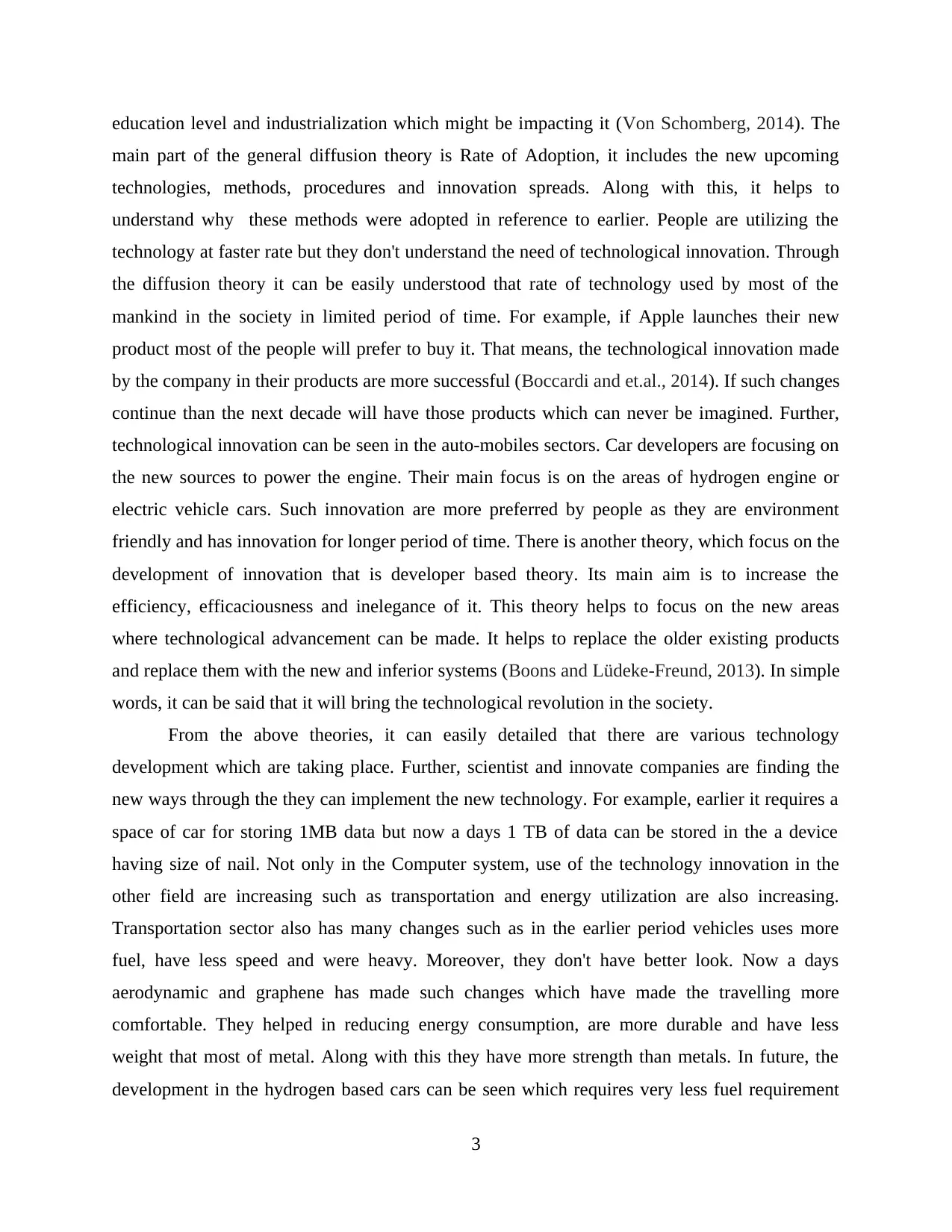
education level and industrialization which might be impacting it (Von Schomberg, 2014). The
main part of the general diffusion theory is Rate of Adoption, it includes the new upcoming
technologies, methods, procedures and innovation spreads. Along with this, it helps to
understand why these methods were adopted in reference to earlier. People are utilizing the
technology at faster rate but they don't understand the need of technological innovation. Through
the diffusion theory it can be easily understood that rate of technology used by most of the
mankind in the society in limited period of time. For example, if Apple launches their new
product most of the people will prefer to buy it. That means, the technological innovation made
by the company in their products are more successful (Boccardi and et.al., 2014). If such changes
continue than the next decade will have those products which can never be imagined. Further,
technological innovation can be seen in the auto-mobiles sectors. Car developers are focusing on
the new sources to power the engine. Their main focus is on the areas of hydrogen engine or
electric vehicle cars. Such innovation are more preferred by people as they are environment
friendly and has innovation for longer period of time. There is another theory, which focus on the
development of innovation that is developer based theory. Its main aim is to increase the
efficiency, efficaciousness and inelegance of it. This theory helps to focus on the new areas
where technological advancement can be made. It helps to replace the older existing products
and replace them with the new and inferior systems (Boons and Lüdeke-Freund, 2013). In simple
words, it can be said that it will bring the technological revolution in the society.
From the above theories, it can easily detailed that there are various technology
development which are taking place. Further, scientist and innovate companies are finding the
new ways through the they can implement the new technology. For example, earlier it requires a
space of car for storing 1MB data but now a days 1 TB of data can be stored in the a device
having size of nail. Not only in the Computer system, use of the technology innovation in the
other field are increasing such as transportation and energy utilization are also increasing.
Transportation sector also has many changes such as in the earlier period vehicles uses more
fuel, have less speed and were heavy. Moreover, they don't have better look. Now a days
aerodynamic and graphene has made such changes which have made the travelling more
comfortable. They helped in reducing energy consumption, are more durable and have less
weight that most of metal. Along with this they have more strength than metals. In future, the
development in the hydrogen based cars can be seen which requires very less fuel requirement
3
main part of the general diffusion theory is Rate of Adoption, it includes the new upcoming
technologies, methods, procedures and innovation spreads. Along with this, it helps to
understand why these methods were adopted in reference to earlier. People are utilizing the
technology at faster rate but they don't understand the need of technological innovation. Through
the diffusion theory it can be easily understood that rate of technology used by most of the
mankind in the society in limited period of time. For example, if Apple launches their new
product most of the people will prefer to buy it. That means, the technological innovation made
by the company in their products are more successful (Boccardi and et.al., 2014). If such changes
continue than the next decade will have those products which can never be imagined. Further,
technological innovation can be seen in the auto-mobiles sectors. Car developers are focusing on
the new sources to power the engine. Their main focus is on the areas of hydrogen engine or
electric vehicle cars. Such innovation are more preferred by people as they are environment
friendly and has innovation for longer period of time. There is another theory, which focus on the
development of innovation that is developer based theory. Its main aim is to increase the
efficiency, efficaciousness and inelegance of it. This theory helps to focus on the new areas
where technological advancement can be made. It helps to replace the older existing products
and replace them with the new and inferior systems (Boons and Lüdeke-Freund, 2013). In simple
words, it can be said that it will bring the technological revolution in the society.
From the above theories, it can easily detailed that there are various technology
development which are taking place. Further, scientist and innovate companies are finding the
new ways through the they can implement the new technology. For example, earlier it requires a
space of car for storing 1MB data but now a days 1 TB of data can be stored in the a device
having size of nail. Not only in the Computer system, use of the technology innovation in the
other field are increasing such as transportation and energy utilization are also increasing.
Transportation sector also has many changes such as in the earlier period vehicles uses more
fuel, have less speed and were heavy. Moreover, they don't have better look. Now a days
aerodynamic and graphene has made such changes which have made the travelling more
comfortable. They helped in reducing energy consumption, are more durable and have less
weight that most of metal. Along with this they have more strength than metals. In future, the
development in the hydrogen based cars can be seen which requires very less fuel requirement
3
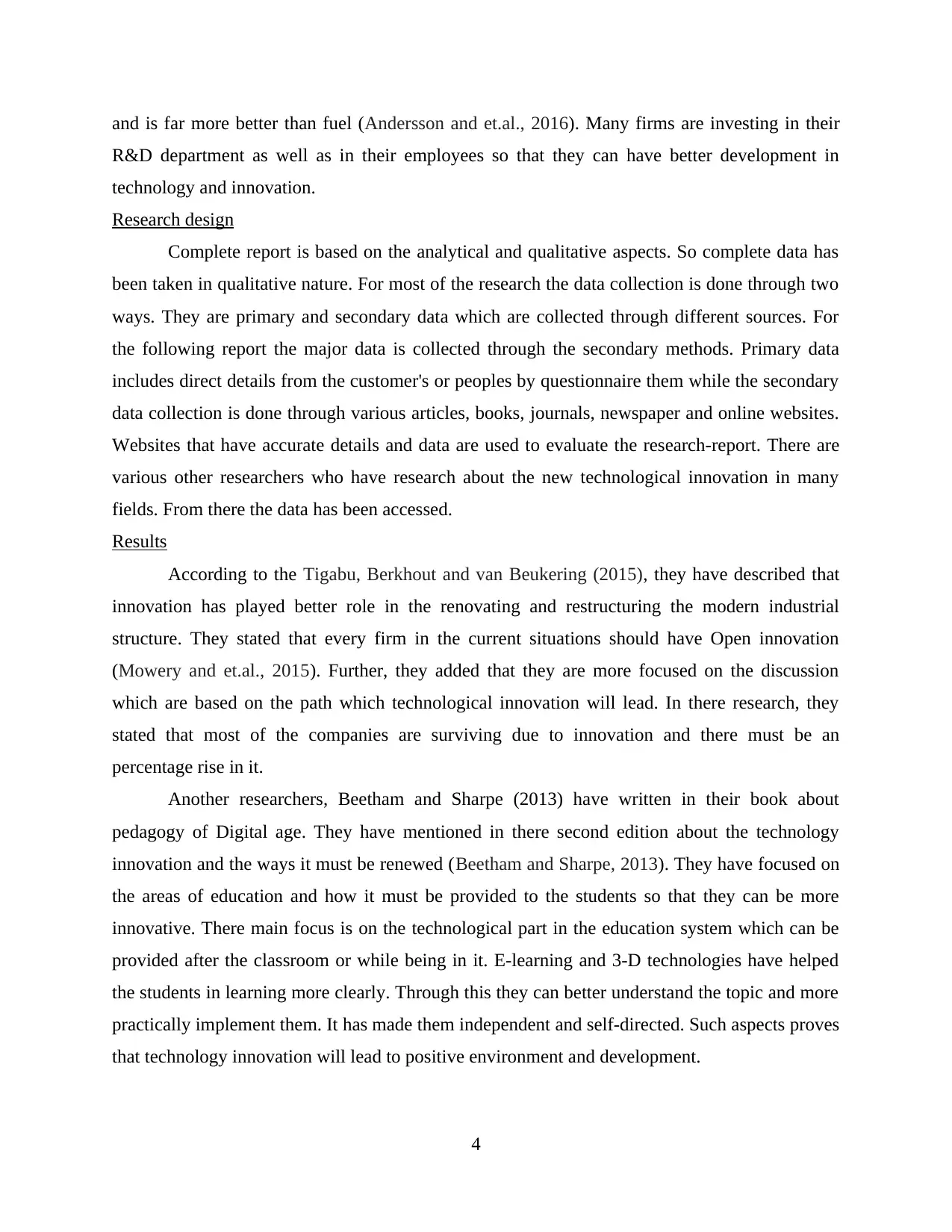
and is far more better than fuel (Andersson and et.al., 2016). Many firms are investing in their
R&D department as well as in their employees so that they can have better development in
technology and innovation.
Research design
Complete report is based on the analytical and qualitative aspects. So complete data has
been taken in qualitative nature. For most of the research the data collection is done through two
ways. They are primary and secondary data which are collected through different sources. For
the following report the major data is collected through the secondary methods. Primary data
includes direct details from the customer's or peoples by questionnaire them while the secondary
data collection is done through various articles, books, journals, newspaper and online websites.
Websites that have accurate details and data are used to evaluate the research-report. There are
various other researchers who have research about the new technological innovation in many
fields. From there the data has been accessed.
Results
According to the Tigabu, Berkhout and van Beukering (2015), they have described that
innovation has played better role in the renovating and restructuring the modern industrial
structure. They stated that every firm in the current situations should have Open innovation
(Mowery and et.al., 2015). Further, they added that they are more focused on the discussion
which are based on the path which technological innovation will lead. In there research, they
stated that most of the companies are surviving due to innovation and there must be an
percentage rise in it.
Another researchers, Beetham and Sharpe (2013) have written in their book about
pedagogy of Digital age. They have mentioned in there second edition about the technology
innovation and the ways it must be renewed (Beetham and Sharpe, 2013). They have focused on
the areas of education and how it must be provided to the students so that they can be more
innovative. There main focus is on the technological part in the education system which can be
provided after the classroom or while being in it. E-learning and 3-D technologies have helped
the students in learning more clearly. Through this they can better understand the topic and more
practically implement them. It has made them independent and self-directed. Such aspects proves
that technology innovation will lead to positive environment and development.
4
R&D department as well as in their employees so that they can have better development in
technology and innovation.
Research design
Complete report is based on the analytical and qualitative aspects. So complete data has
been taken in qualitative nature. For most of the research the data collection is done through two
ways. They are primary and secondary data which are collected through different sources. For
the following report the major data is collected through the secondary methods. Primary data
includes direct details from the customer's or peoples by questionnaire them while the secondary
data collection is done through various articles, books, journals, newspaper and online websites.
Websites that have accurate details and data are used to evaluate the research-report. There are
various other researchers who have research about the new technological innovation in many
fields. From there the data has been accessed.
Results
According to the Tigabu, Berkhout and van Beukering (2015), they have described that
innovation has played better role in the renovating and restructuring the modern industrial
structure. They stated that every firm in the current situations should have Open innovation
(Mowery and et.al., 2015). Further, they added that they are more focused on the discussion
which are based on the path which technological innovation will lead. In there research, they
stated that most of the companies are surviving due to innovation and there must be an
percentage rise in it.
Another researchers, Beetham and Sharpe (2013) have written in their book about
pedagogy of Digital age. They have mentioned in there second edition about the technology
innovation and the ways it must be renewed (Beetham and Sharpe, 2013). They have focused on
the areas of education and how it must be provided to the students so that they can be more
innovative. There main focus is on the technological part in the education system which can be
provided after the classroom or while being in it. E-learning and 3-D technologies have helped
the students in learning more clearly. Through this they can better understand the topic and more
practically implement them. It has made them independent and self-directed. Such aspects proves
that technology innovation will lead to positive environment and development.
4
⊘ This is a preview!⊘
Do you want full access?
Subscribe today to unlock all pages.

Trusted by 1+ million students worldwide
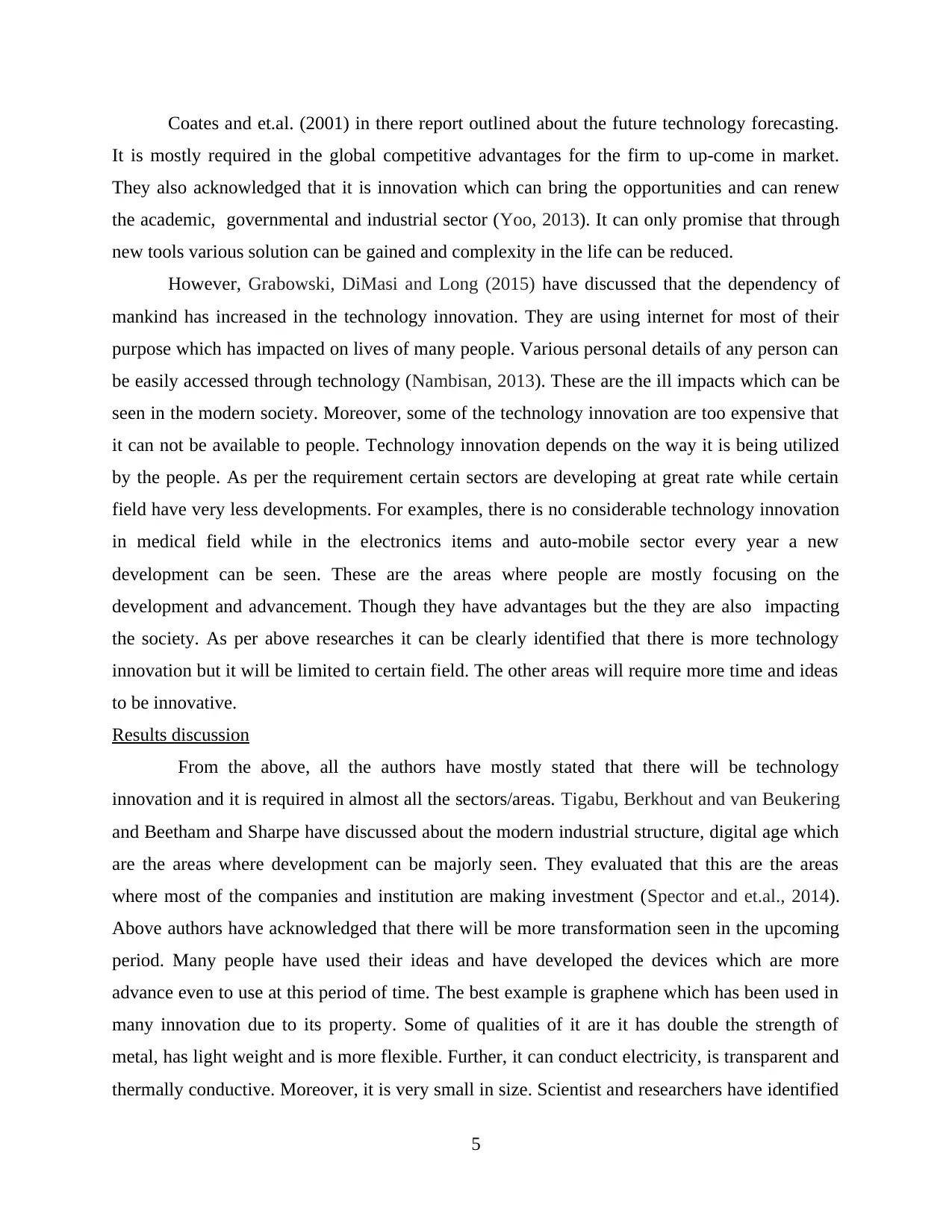
Coates and et.al. (2001) in there report outlined about the future technology forecasting.
It is mostly required in the global competitive advantages for the firm to up-come in market.
They also acknowledged that it is innovation which can bring the opportunities and can renew
the academic, governmental and industrial sector (Yoo, 2013). It can only promise that through
new tools various solution can be gained and complexity in the life can be reduced.
However, Grabowski, DiMasi and Long (2015) have discussed that the dependency of
mankind has increased in the technology innovation. They are using internet for most of their
purpose which has impacted on lives of many people. Various personal details of any person can
be easily accessed through technology (Nambisan, 2013). These are the ill impacts which can be
seen in the modern society. Moreover, some of the technology innovation are too expensive that
it can not be available to people. Technology innovation depends on the way it is being utilized
by the people. As per the requirement certain sectors are developing at great rate while certain
field have very less developments. For examples, there is no considerable technology innovation
in medical field while in the electronics items and auto-mobile sector every year a new
development can be seen. These are the areas where people are mostly focusing on the
development and advancement. Though they have advantages but the they are also impacting
the society. As per above researches it can be clearly identified that there is more technology
innovation but it will be limited to certain field. The other areas will require more time and ideas
to be innovative.
Results discussion
From the above, all the authors have mostly stated that there will be technology
innovation and it is required in almost all the sectors/areas. Tigabu, Berkhout and van Beukering
and Beetham and Sharpe have discussed about the modern industrial structure, digital age which
are the areas where development can be majorly seen. They evaluated that this are the areas
where most of the companies and institution are making investment (Spector and et.al., 2014).
Above authors have acknowledged that there will be more transformation seen in the upcoming
period. Many people have used their ideas and have developed the devices which are more
advance even to use at this period of time. The best example is graphene which has been used in
many innovation due to its property. Some of qualities of it are it has double the strength of
metal, has light weight and is more flexible. Further, it can conduct electricity, is transparent and
thermally conductive. Moreover, it is very small in size. Scientist and researchers have identified
5
It is mostly required in the global competitive advantages for the firm to up-come in market.
They also acknowledged that it is innovation which can bring the opportunities and can renew
the academic, governmental and industrial sector (Yoo, 2013). It can only promise that through
new tools various solution can be gained and complexity in the life can be reduced.
However, Grabowski, DiMasi and Long (2015) have discussed that the dependency of
mankind has increased in the technology innovation. They are using internet for most of their
purpose which has impacted on lives of many people. Various personal details of any person can
be easily accessed through technology (Nambisan, 2013). These are the ill impacts which can be
seen in the modern society. Moreover, some of the technology innovation are too expensive that
it can not be available to people. Technology innovation depends on the way it is being utilized
by the people. As per the requirement certain sectors are developing at great rate while certain
field have very less developments. For examples, there is no considerable technology innovation
in medical field while in the electronics items and auto-mobile sector every year a new
development can be seen. These are the areas where people are mostly focusing on the
development and advancement. Though they have advantages but the they are also impacting
the society. As per above researches it can be clearly identified that there is more technology
innovation but it will be limited to certain field. The other areas will require more time and ideas
to be innovative.
Results discussion
From the above, all the authors have mostly stated that there will be technology
innovation and it is required in almost all the sectors/areas. Tigabu, Berkhout and van Beukering
and Beetham and Sharpe have discussed about the modern industrial structure, digital age which
are the areas where development can be majorly seen. They evaluated that this are the areas
where most of the companies and institution are making investment (Spector and et.al., 2014).
Above authors have acknowledged that there will be more transformation seen in the upcoming
period. Many people have used their ideas and have developed the devices which are more
advance even to use at this period of time. The best example is graphene which has been used in
many innovation due to its property. Some of qualities of it are it has double the strength of
metal, has light weight and is more flexible. Further, it can conduct electricity, is transparent and
thermally conductive. Moreover, it is very small in size. Scientist and researchers have identified
5
Paraphrase This Document
Need a fresh take? Get an instant paraphrase of this document with our AI Paraphraser
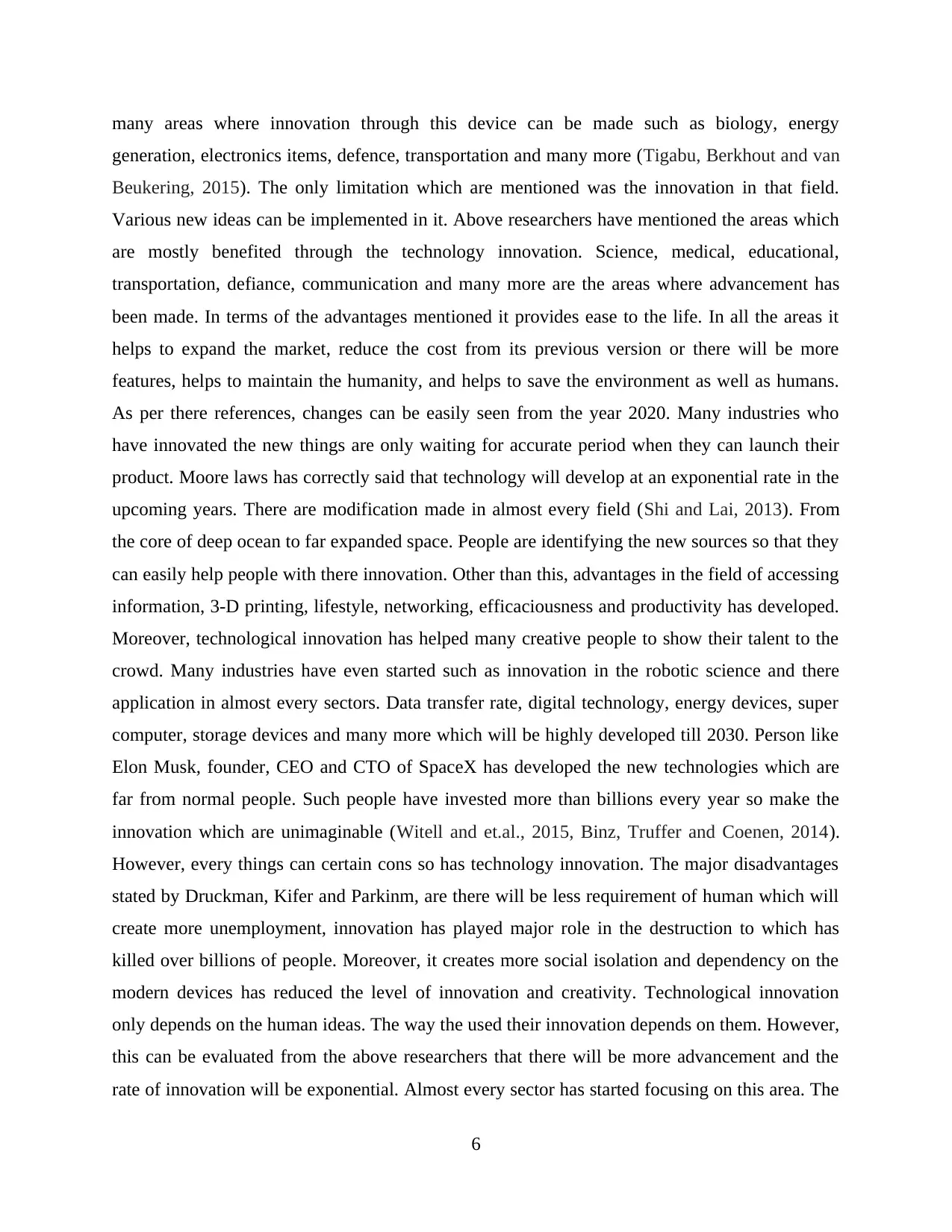
many areas where innovation through this device can be made such as biology, energy
generation, electronics items, defence, transportation and many more (Tigabu, Berkhout and van
Beukering, 2015). The only limitation which are mentioned was the innovation in that field.
Various new ideas can be implemented in it. Above researchers have mentioned the areas which
are mostly benefited through the technology innovation. Science, medical, educational,
transportation, defiance, communication and many more are the areas where advancement has
been made. In terms of the advantages mentioned it provides ease to the life. In all the areas it
helps to expand the market, reduce the cost from its previous version or there will be more
features, helps to maintain the humanity, and helps to save the environment as well as humans.
As per there references, changes can be easily seen from the year 2020. Many industries who
have innovated the new things are only waiting for accurate period when they can launch their
product. Moore laws has correctly said that technology will develop at an exponential rate in the
upcoming years. There are modification made in almost every field (Shi and Lai, 2013). From
the core of deep ocean to far expanded space. People are identifying the new sources so that they
can easily help people with there innovation. Other than this, advantages in the field of accessing
information, 3-D printing, lifestyle, networking, efficaciousness and productivity has developed.
Moreover, technological innovation has helped many creative people to show their talent to the
crowd. Many industries have even started such as innovation in the robotic science and there
application in almost every sectors. Data transfer rate, digital technology, energy devices, super
computer, storage devices and many more which will be highly developed till 2030. Person like
Elon Musk, founder, CEO and CTO of SpaceX has developed the new technologies which are
far from normal people. Such people have invested more than billions every year so make the
innovation which are unimaginable (Witell and et.al., 2015, Binz, Truffer and Coenen, 2014).
However, every things can certain cons so has technology innovation. The major disadvantages
stated by Druckman, Kifer and Parkinm, are there will be less requirement of human which will
create more unemployment, innovation has played major role in the destruction to which has
killed over billions of people. Moreover, it creates more social isolation and dependency on the
modern devices has reduced the level of innovation and creativity. Technological innovation
only depends on the human ideas. The way the used their innovation depends on them. However,
this can be evaluated from the above researchers that there will be more advancement and the
rate of innovation will be exponential. Almost every sector has started focusing on this area. The
6
generation, electronics items, defence, transportation and many more (Tigabu, Berkhout and van
Beukering, 2015). The only limitation which are mentioned was the innovation in that field.
Various new ideas can be implemented in it. Above researchers have mentioned the areas which
are mostly benefited through the technology innovation. Science, medical, educational,
transportation, defiance, communication and many more are the areas where advancement has
been made. In terms of the advantages mentioned it provides ease to the life. In all the areas it
helps to expand the market, reduce the cost from its previous version or there will be more
features, helps to maintain the humanity, and helps to save the environment as well as humans.
As per there references, changes can be easily seen from the year 2020. Many industries who
have innovated the new things are only waiting for accurate period when they can launch their
product. Moore laws has correctly said that technology will develop at an exponential rate in the
upcoming years. There are modification made in almost every field (Shi and Lai, 2013). From
the core of deep ocean to far expanded space. People are identifying the new sources so that they
can easily help people with there innovation. Other than this, advantages in the field of accessing
information, 3-D printing, lifestyle, networking, efficaciousness and productivity has developed.
Moreover, technological innovation has helped many creative people to show their talent to the
crowd. Many industries have even started such as innovation in the robotic science and there
application in almost every sectors. Data transfer rate, digital technology, energy devices, super
computer, storage devices and many more which will be highly developed till 2030. Person like
Elon Musk, founder, CEO and CTO of SpaceX has developed the new technologies which are
far from normal people. Such people have invested more than billions every year so make the
innovation which are unimaginable (Witell and et.al., 2015, Binz, Truffer and Coenen, 2014).
However, every things can certain cons so has technology innovation. The major disadvantages
stated by Druckman, Kifer and Parkinm, are there will be less requirement of human which will
create more unemployment, innovation has played major role in the destruction to which has
killed over billions of people. Moreover, it creates more social isolation and dependency on the
modern devices has reduced the level of innovation and creativity. Technological innovation
only depends on the human ideas. The way the used their innovation depends on them. However,
this can be evaluated from the above researchers that there will be more advancement and the
rate of innovation will be exponential. Almost every sector has started focusing on this area. The
6
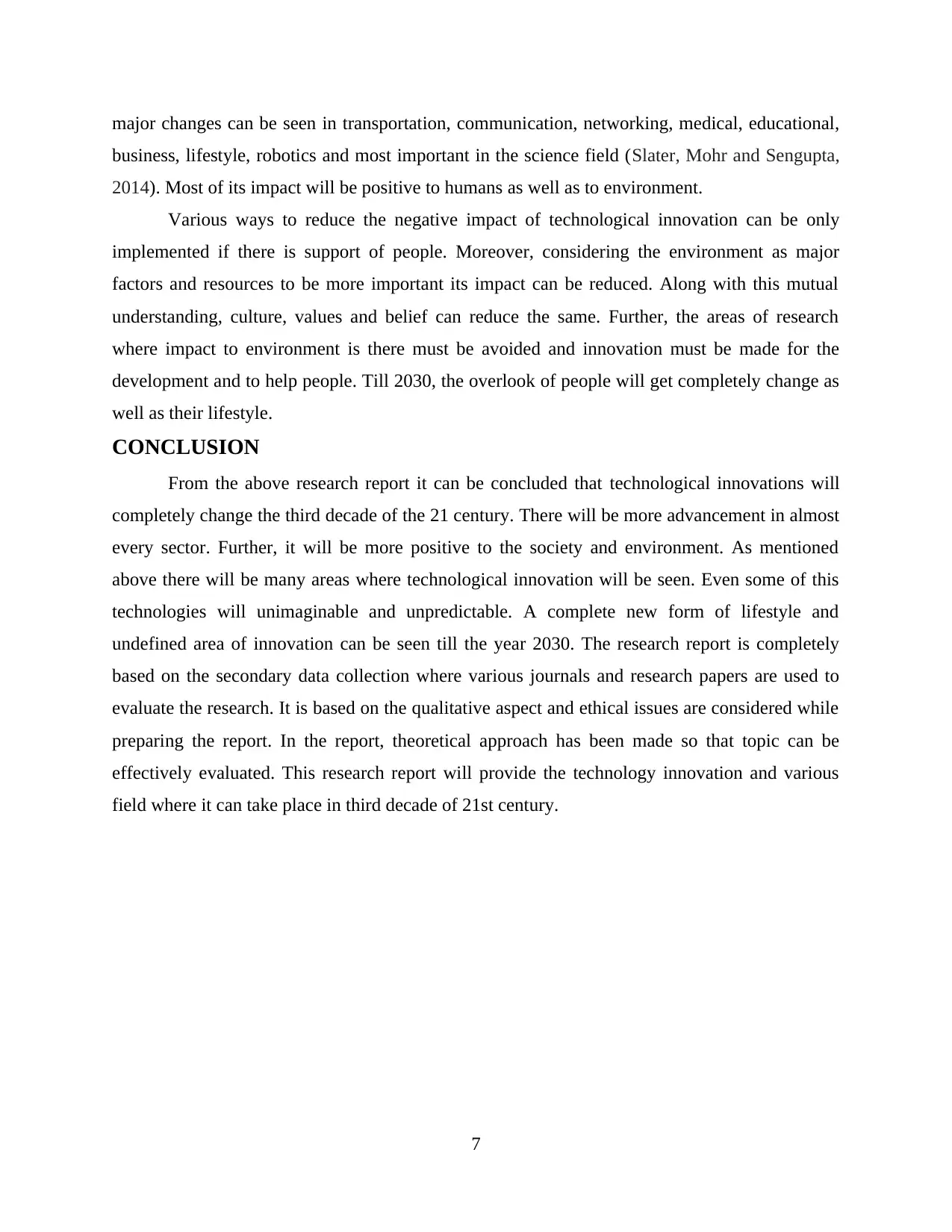
major changes can be seen in transportation, communication, networking, medical, educational,
business, lifestyle, robotics and most important in the science field (Slater, Mohr and Sengupta,
2014). Most of its impact will be positive to humans as well as to environment.
Various ways to reduce the negative impact of technological innovation can be only
implemented if there is support of people. Moreover, considering the environment as major
factors and resources to be more important its impact can be reduced. Along with this mutual
understanding, culture, values and belief can reduce the same. Further, the areas of research
where impact to environment is there must be avoided and innovation must be made for the
development and to help people. Till 2030, the overlook of people will get completely change as
well as their lifestyle.
CONCLUSION
From the above research report it can be concluded that technological innovations will
completely change the third decade of the 21 century. There will be more advancement in almost
every sector. Further, it will be more positive to the society and environment. As mentioned
above there will be many areas where technological innovation will be seen. Even some of this
technologies will unimaginable and unpredictable. A complete new form of lifestyle and
undefined area of innovation can be seen till the year 2030. The research report is completely
based on the secondary data collection where various journals and research papers are used to
evaluate the research. It is based on the qualitative aspect and ethical issues are considered while
preparing the report. In the report, theoretical approach has been made so that topic can be
effectively evaluated. This research report will provide the technology innovation and various
field where it can take place in third decade of 21st century.
7
business, lifestyle, robotics and most important in the science field (Slater, Mohr and Sengupta,
2014). Most of its impact will be positive to humans as well as to environment.
Various ways to reduce the negative impact of technological innovation can be only
implemented if there is support of people. Moreover, considering the environment as major
factors and resources to be more important its impact can be reduced. Along with this mutual
understanding, culture, values and belief can reduce the same. Further, the areas of research
where impact to environment is there must be avoided and innovation must be made for the
development and to help people. Till 2030, the overlook of people will get completely change as
well as their lifestyle.
CONCLUSION
From the above research report it can be concluded that technological innovations will
completely change the third decade of the 21 century. There will be more advancement in almost
every sector. Further, it will be more positive to the society and environment. As mentioned
above there will be many areas where technological innovation will be seen. Even some of this
technologies will unimaginable and unpredictable. A complete new form of lifestyle and
undefined area of innovation can be seen till the year 2030. The research report is completely
based on the secondary data collection where various journals and research papers are used to
evaluate the research. It is based on the qualitative aspect and ethical issues are considered while
preparing the report. In the report, theoretical approach has been made so that topic can be
effectively evaluated. This research report will provide the technology innovation and various
field where it can take place in third decade of 21st century.
7
⊘ This is a preview!⊘
Do you want full access?
Subscribe today to unlock all pages.

Trusted by 1+ million students worldwide
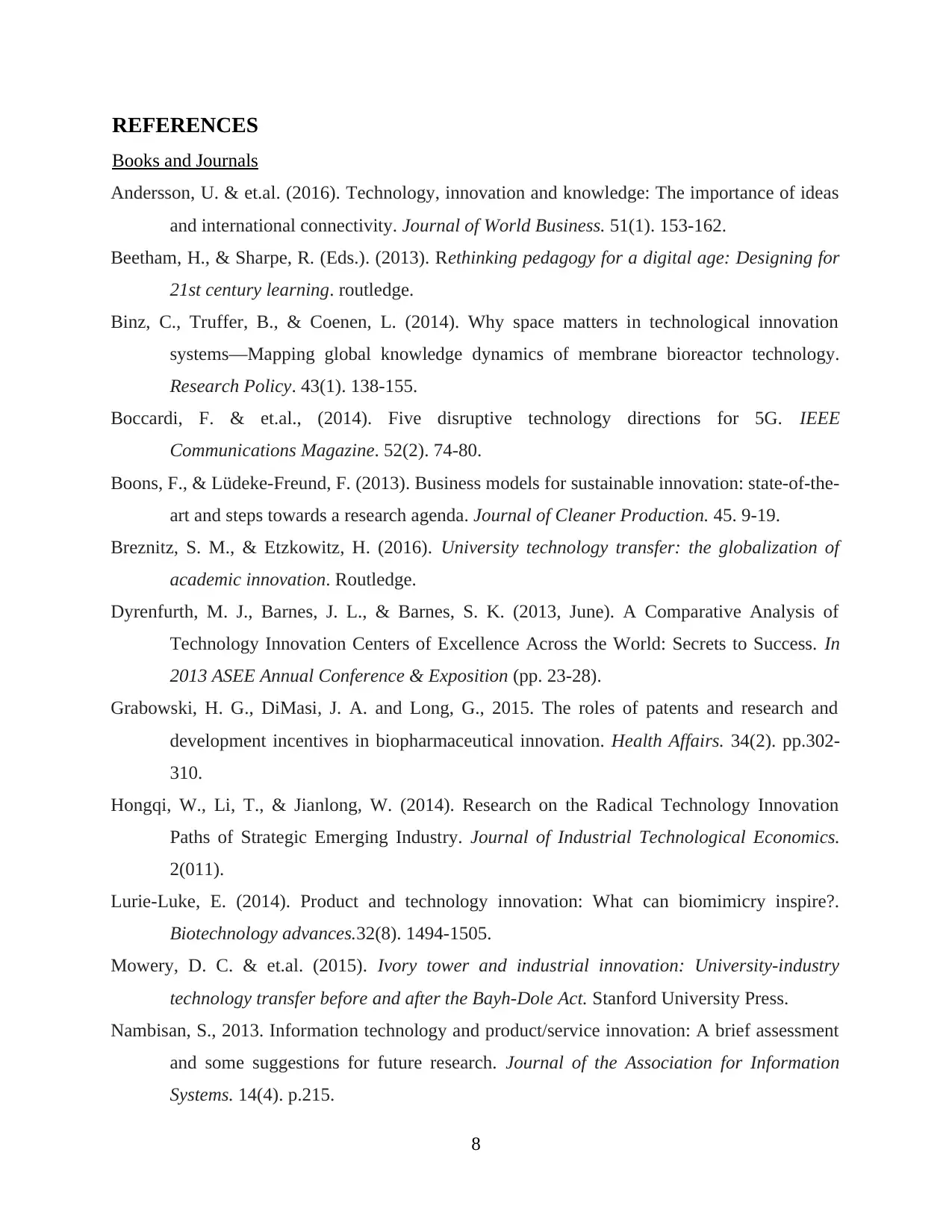
REFERENCES
Books and Journals
Andersson, U. & et.al. (2016). Technology, innovation and knowledge: The importance of ideas
and international connectivity. Journal of World Business. 51(1). 153-162.
Beetham, H., & Sharpe, R. (Eds.). (2013). Rethinking pedagogy for a digital age: Designing for
21st century learning. routledge.
Binz, C., Truffer, B., & Coenen, L. (2014). Why space matters in technological innovation
systems—Mapping global knowledge dynamics of membrane bioreactor technology.
Research Policy. 43(1). 138-155.
Boccardi, F. & et.al., (2014). Five disruptive technology directions for 5G. IEEE
Communications Magazine. 52(2). 74-80.
Boons, F., & Lüdeke-Freund, F. (2013). Business models for sustainable innovation: state-of-the-
art and steps towards a research agenda. Journal of Cleaner Production. 45. 9-19.
Breznitz, S. M., & Etzkowitz, H. (2016). University technology transfer: the globalization of
academic innovation. Routledge.
Dyrenfurth, M. J., Barnes, J. L., & Barnes, S. K. (2013, June). A Comparative Analysis of
Technology Innovation Centers of Excellence Across the World: Secrets to Success. In
2013 ASEE Annual Conference & Exposition (pp. 23-28).
Grabowski, H. G., DiMasi, J. A. and Long, G., 2015. The roles of patents and research and
development incentives in biopharmaceutical innovation. Health Affairs. 34(2). pp.302-
310.
Hongqi, W., Li, T., & Jianlong, W. (2014). Research on the Radical Technology Innovation
Paths of Strategic Emerging Industry. Journal of Industrial Technological Economics.
2(011).
Lurie-Luke, E. (2014). Product and technology innovation: What can biomimicry inspire?.
Biotechnology advances.32(8). 1494-1505.
Mowery, D. C. & et.al. (2015). Ivory tower and industrial innovation: University-industry
technology transfer before and after the Bayh-Dole Act. Stanford University Press.
Nambisan, S., 2013. Information technology and product/service innovation: A brief assessment
and some suggestions for future research. Journal of the Association for Information
Systems. 14(4). p.215.
8
Books and Journals
Andersson, U. & et.al. (2016). Technology, innovation and knowledge: The importance of ideas
and international connectivity. Journal of World Business. 51(1). 153-162.
Beetham, H., & Sharpe, R. (Eds.). (2013). Rethinking pedagogy for a digital age: Designing for
21st century learning. routledge.
Binz, C., Truffer, B., & Coenen, L. (2014). Why space matters in technological innovation
systems—Mapping global knowledge dynamics of membrane bioreactor technology.
Research Policy. 43(1). 138-155.
Boccardi, F. & et.al., (2014). Five disruptive technology directions for 5G. IEEE
Communications Magazine. 52(2). 74-80.
Boons, F., & Lüdeke-Freund, F. (2013). Business models for sustainable innovation: state-of-the-
art and steps towards a research agenda. Journal of Cleaner Production. 45. 9-19.
Breznitz, S. M., & Etzkowitz, H. (2016). University technology transfer: the globalization of
academic innovation. Routledge.
Dyrenfurth, M. J., Barnes, J. L., & Barnes, S. K. (2013, June). A Comparative Analysis of
Technology Innovation Centers of Excellence Across the World: Secrets to Success. In
2013 ASEE Annual Conference & Exposition (pp. 23-28).
Grabowski, H. G., DiMasi, J. A. and Long, G., 2015. The roles of patents and research and
development incentives in biopharmaceutical innovation. Health Affairs. 34(2). pp.302-
310.
Hongqi, W., Li, T., & Jianlong, W. (2014). Research on the Radical Technology Innovation
Paths of Strategic Emerging Industry. Journal of Industrial Technological Economics.
2(011).
Lurie-Luke, E. (2014). Product and technology innovation: What can biomimicry inspire?.
Biotechnology advances.32(8). 1494-1505.
Mowery, D. C. & et.al. (2015). Ivory tower and industrial innovation: University-industry
technology transfer before and after the Bayh-Dole Act. Stanford University Press.
Nambisan, S., 2013. Information technology and product/service innovation: A brief assessment
and some suggestions for future research. Journal of the Association for Information
Systems. 14(4). p.215.
8
Paraphrase This Document
Need a fresh take? Get an instant paraphrase of this document with our AI Paraphraser
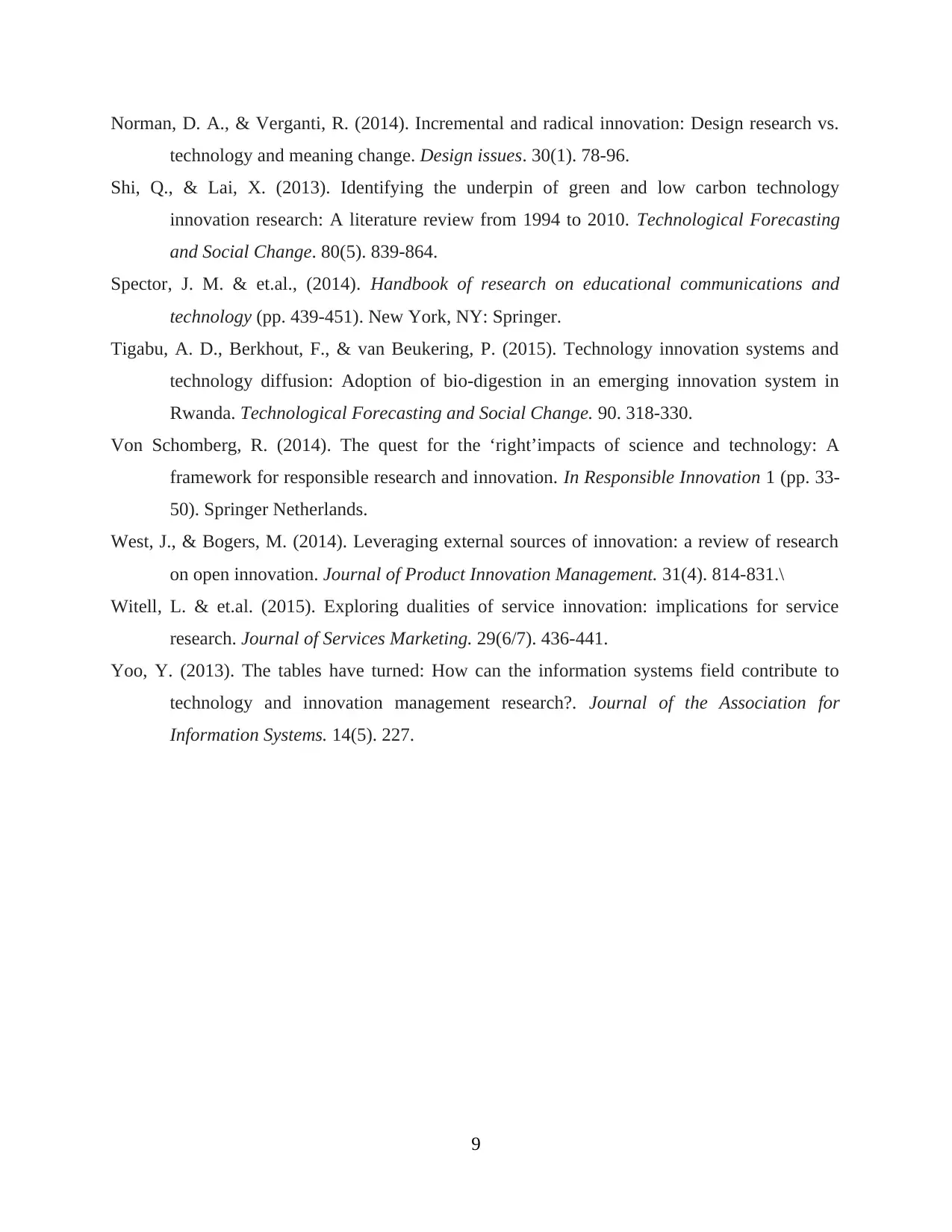
Norman, D. A., & Verganti, R. (2014). Incremental and radical innovation: Design research vs.
technology and meaning change. Design issues. 30(1). 78-96.
Shi, Q., & Lai, X. (2013). Identifying the underpin of green and low carbon technology
innovation research: A literature review from 1994 to 2010. Technological Forecasting
and Social Change. 80(5). 839-864.
Spector, J. M. & et.al., (2014). Handbook of research on educational communications and
technology (pp. 439-451). New York, NY: Springer.
Tigabu, A. D., Berkhout, F., & van Beukering, P. (2015). Technology innovation systems and
technology diffusion: Adoption of bio-digestion in an emerging innovation system in
Rwanda. Technological Forecasting and Social Change. 90. 318-330.
Von Schomberg, R. (2014). The quest for the ‘right’impacts of science and technology: A
framework for responsible research and innovation. In Responsible Innovation 1 (pp. 33-
50). Springer Netherlands.
West, J., & Bogers, M. (2014). Leveraging external sources of innovation: a review of research
on open innovation. Journal of Product Innovation Management. 31(4). 814-831.\
Witell, L. & et.al. (2015). Exploring dualities of service innovation: implications for service
research. Journal of Services Marketing. 29(6/7). 436-441.
Yoo, Y. (2013). The tables have turned: How can the information systems field contribute to
technology and innovation management research?. Journal of the Association for
Information Systems. 14(5). 227.
9
technology and meaning change. Design issues. 30(1). 78-96.
Shi, Q., & Lai, X. (2013). Identifying the underpin of green and low carbon technology
innovation research: A literature review from 1994 to 2010. Technological Forecasting
and Social Change. 80(5). 839-864.
Spector, J. M. & et.al., (2014). Handbook of research on educational communications and
technology (pp. 439-451). New York, NY: Springer.
Tigabu, A. D., Berkhout, F., & van Beukering, P. (2015). Technology innovation systems and
technology diffusion: Adoption of bio-digestion in an emerging innovation system in
Rwanda. Technological Forecasting and Social Change. 90. 318-330.
Von Schomberg, R. (2014). The quest for the ‘right’impacts of science and technology: A
framework for responsible research and innovation. In Responsible Innovation 1 (pp. 33-
50). Springer Netherlands.
West, J., & Bogers, M. (2014). Leveraging external sources of innovation: a review of research
on open innovation. Journal of Product Innovation Management. 31(4). 814-831.\
Witell, L. & et.al. (2015). Exploring dualities of service innovation: implications for service
research. Journal of Services Marketing. 29(6/7). 436-441.
Yoo, Y. (2013). The tables have turned: How can the information systems field contribute to
technology and innovation management research?. Journal of the Association for
Information Systems. 14(5). 227.
9
1 out of 11
Related Documents
Your All-in-One AI-Powered Toolkit for Academic Success.
+13062052269
info@desklib.com
Available 24*7 on WhatsApp / Email
![[object Object]](/_next/static/media/star-bottom.7253800d.svg)
Unlock your academic potential
Copyright © 2020–2025 A2Z Services. All Rights Reserved. Developed and managed by ZUCOL.





